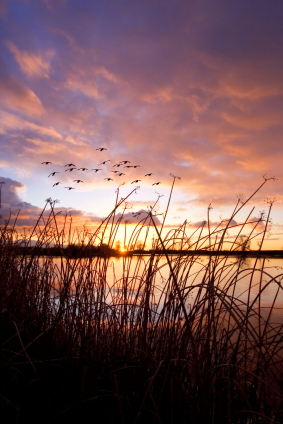Protecting Your Land with Easements and Ducks Unlimited

As a landowner interested in conservation, you want to get the full potential from your land. But how?
Ducks Unlimited just might have the answer.
DU’s Conservation Easements Program ─ one of the most effective methods we use to protect North America’s valuable natural resources ─ is a partnership between DU and landowners that benefits conservation while giving you the chance to leave a legacy with your property.
So how exactly do easements work? Easements are voluntary legal agreements made between DU and property owners restricting, but not eliminating, the type and amount of development that may take place on the property. Since close to 75 percent of America’s wetlands are on private lands, this partnership plays a critical role in DU’s conservation mission.
The benefits of easements for conservation might seem clear, but those benefits extend significantly to you as well. As part of the partnership established with the Ducks Unlimited Wetlands America Trust through easements, landowners receive:
- Guidance from DU in land management practices to ensure the continued use of the property is consistent with and protects its conservation values
- Potential tax benefits, including the possibility of a federal income tax deduction for the value of the easement up to 30 percent of adjusted gross income
- Assurance that DU will assume a perpetual obligation to monitor the property and enforce the terms of the easement
Perhaps most importantly, easements provide you with a unique opportunity to leave a legacy. With the land protection that DU provides through easements, you can be sure that large acreages of wetlands, riparian habitats and important uplands will be preserved for the benefits of waterfowl and other wildlife and the enjoyment of future generations.
DU has earned the reputation as the world’s leader in wetlands and waterfowl conservation, and its conservation easements program, a valuable partnership between DU and landowners, helps ensure its ability to fill the skies with waterfowl today, tomorrow and forever.
United Country is a proud sponsor of Ducks Unlimited and is committed to land stewardship while helping landowners find their freedom.
As we celebrate United Country’s 85 years of heritage this month, we can’t help but take note of the other exciting things that happened in 1925, the year United was
“Wordle is a toy for generating “word clouds” from text that you provide. The clouds give greater prominence to words that appear more frequently in the source text.” Here is
Recent Posts
Archives
- May 2020
- April 2020
- March 2020
- February 2020
- November 2019
- September 2019
- August 2019
- April 2019
- March 2019
- January 2019
- November 2018
- October 2018
- September 2018
- August 2018
- April 2018
- January 2018
- September 2017
- August 2017
- June 2017
- April 2017
- March 2017
- January 2017
- December 2016
- November 2016
- October 2016
- September 2016
- July 2016
- June 2016
- May 2016
- April 2016
- March 2016
- December 2015
- November 2015
- October 2015
- September 2015
- August 2015
- July 2015
- January 2015
- December 2014
- August 2014
- July 2014
- June 2014
- February 2014
- December 2013
- November 2013
- October 2013
- August 2013
- January 2013
- June 2012
- May 2012
- April 2012
- March 2012
- January 2012
- May 2011
- April 2011
- February 2011
- December 2010
- November 2010
- October 2010
- September 2010
- August 2010
- July 2010
- June 2010
- May 2010
- April 2010
- March 2010
- February 2010
